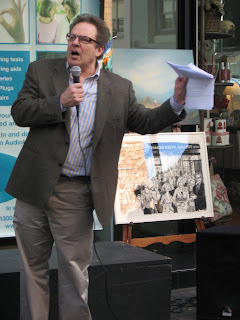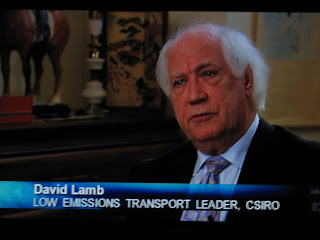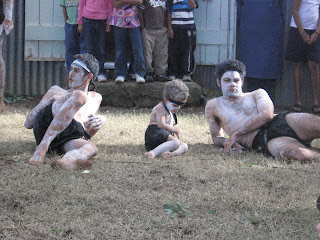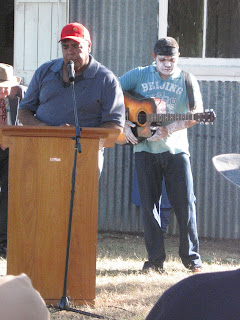 John McDonald's pan of Sydney's 2008 Biennale (The Sydney Morning Herald 29 June) is saturated with ennui.
John McDonald's pan of Sydney's 2008 Biennale (The Sydney Morning Herald 29 June) is saturated with ennui.It's a kind of approach to art that I thought had passed long ago into oblivion along with society's rejection of the Impressionists. Australia's incredulous reviewers practically choked on their mutton and McDonald is doing likewise faced with Carolyn Christov-Bakargiev's Biennale of Sydney 2008.
She sought "a sudden shift in perspective" (SMH 23 June) which includes what Angela Bennie labels "a lodestone or spinal cord" running through the exhibition: the "old tat" and "old hat" McDonald sniffs at. There is a lot of stuff from the early 20th century and even more from the 1960s.
Bennie liberally dubs two works a "quixotic" addition and it is in this spirit that Christov-Bakargiev's effort must be judged.
On the blog Speech Interviews, 29 April, Christov-Bakargiev talks about "a constant celebration of uncertainty, failure of the narrative" in relation to one artist, William Kentridge, who screened this afternoon on the ABC talking with Virginia Trioli.
In the June 2008 issue (38) of Artwrite (available online) Christov-Bakargiev again refers to "an open path for change and encourages doubt, uncertainties and failure, as a path to freedom".
But McDonald is possibly part of the problem. Perhaps he's been in the driving seat too long to get it.
In his piece today, McDonald derides the sorbet Christov-Bakargiev included to freshen our palates in preparation for the more recent work - all those pieces from last century he regrets because "their presence seems, at best, superfluous" they are so familiar.
I beg to differ.
Even those of us who studied fine art at tertiary level do not possess perfect recall. It is fun - great fun - to be reminded of these knickknacks.
But McDonald's understanding of revolution in general is so two-dimensional and simplistic we involuntarily reach for our gun when he derides "uprisings in the streets of Paris and Prague" and "millions of people waving little red books in China".
Paris, he avers "was a complete fizzer" and since the Czechs were "suppressed" (oddly bureaucratic term, John) their revolution was futile.
The Chinese, he opines, "are still trying to forget" the Cultural Revolution. This historical approach is "old tat" and "old hat" but McDonald is so on top of the material his only link to the present is to thumb his nose at Robert Mugabe in ex-Rhodesia:
In present-day politics, Robert Mugabe stands out as a revolutionary leader who has kept up the bad old associations with arbitrary violence and totalitarianism.
This is not historical analysis and I regret to say that I find McDonald's equally bland ideas about the exhbits similarly uninspiring. Not that I agree with Mugabe. But Mugabe is not the point.
The point is that western Europe - specifically, protestant England - took hundreds of years acclimatising to notions of citizenship (as opposed to subjection, the state of being a 'subject').
Other parts of the world did not. Italy, Germany, Spain, Portugal, Japan - these countries went through in the 20th century what England - and by extension America, Canada, Australia and New Zealand - went through during the Commonwealth (their so-called 'interregnum').
Jumping straight from the middle ages into modernity - as China did last century - had never been attempted. They had no manual. They didn't even have a script. Neither did the Russians - which isn't really a European country anyway.
Frank Moorhouse was the first novelist to catch onto what happened after WWI. In Grand Days (1993) and Dark Palace (2000) Moorhouse examines the beginnings of a new world order.
Post-nationalism, or trans-nationalism, is where McDonald was brought up. Within the comfortable confines of its guiding ethos privileging diplomacy over war, behind-the-scenes over behind-the-barricades, spin over manifesto.
Emphasis on 'guiding'. This is what Christov-Bakargiev wants to challenge.
So it's not really surprising that the Herald''s chief art critic heaps opprobrium on her attempt to do what has seldom been done except on a few 1970s albums: turn back the clock.
Or at least imagine turning it back. She wants us to have a taste of 'then' by linking it with 'now'. By reexperiencing the past we may 'imagine' the future.
And I think it's good. What does McDonald know about the Winter Palace?
I like Ranbir Kaleka (see pic for detail from a drawing included in the catalogue - Thames & Hudson, $59.95). Kaleka's He was a good man (2007-08) is a wonderful tableau vivant in ironically kitsch style.
An old man sits in a small hut or hovel holding a needle that he seems to thread. His gnarled hands are suspended before his acne-scarred face. They move slightly. In fact, the whole object shivers and twitches with the actuality of living flesh.
But the needle never gets threaded. There is no narrative.
The lime-green highlights on his arms evoke the classic kitsch of Russian painter Vladimir Tretchikoff, who died two years ago. “Painted in 1952, Chinese Girl became the world’s biggest-selling print,” wrote the SMH on 28 August 2006.
Sounds emanate from beyond the walls around him. Images flicker on and flicker off. An immediate analogue in popular culture - apart from Tretchikoff - would be the incredible early VR games of the 1990s.
McDonald mentions in passing Jesus Soto but he fails to invoke the richness of Soto's 1977 visual display - an abstract bird of paradise - Triptico Azul, Negro y Violeta.
More recently, Mark Dion has made an interesting 'performance', inasmuch as the parcels that constitute a major part of the installation were, in fact, mailed to Christov-Bukargiev for the Biennale.
The Return (A Cosmological Cabinet for New South Wales) (2008) encapsulates a lot of confusion surrounding the traditional (now) post-colonial narrative. Each packet must not be opened, Dion demanded. (Here's where we can start talking about Mugabe.)
They are lined up on shelves in a red-stained wooden "hutch" (actually, it's more like a bookcase or a dresser). There's a small parcel from Canada in the 'water/hearing' sector of the hutch and from Indonesia there's a parcel in the 'earth/sight' sector.
A "bird call" in a cylinder - I couldn't make out the provenance - is in the 'water/touch' sector and, from Murcia (Spain), there's an 'air/smell' parcel. From Folkestone, Kent, there's an 'earth/smell' box and there's another Indonesian package: in the 'fire/hearing' sector.
On the bottom (which is for "the underworld" or 'chaos') we see an almost full shelf which includes some "children's blocks" that passed quarantine.
Each item is thus classified and they are not to be opened because Dion "refuses to engage" in the possession of knowledge inherent in classification. But how are they to be classified if they are not open?
Who is to judge?








































































